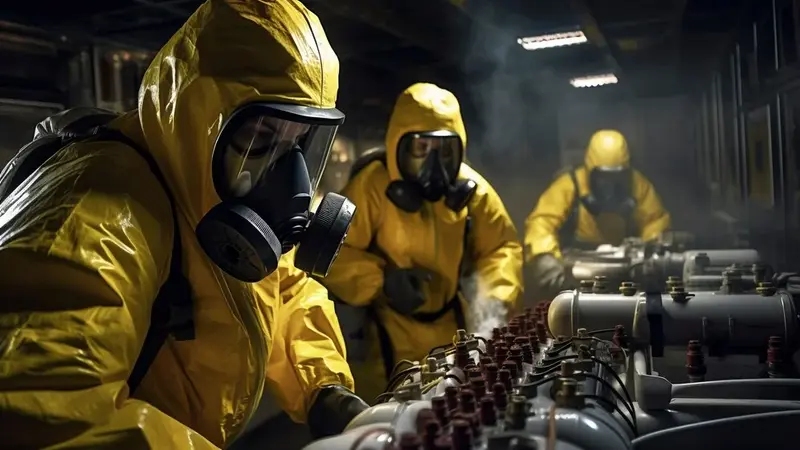In today’s industrial landscape, handling hazardous materials is a common yet critical task requiring stringent safeguards. Ensuring the protection of both workers and the environment is not only a legal obligation but a moral one as well. This post outlines key guidelines to efficiently manage hazardous materials, providing a safe work environment while also safeguarding our natural surroundings. Whether you’re a factory manager or a concerned citizen, understanding these protocols is paramount for community safety and environmental preservation.
Understanding Hazardous Materials
Hazardous materials, or hazmats, encompass a wide range of substances that can pose risks to health, safety, or the environment. These materials can be chemical, biological, or radioactive. It’s crucial for businesses and individuals handling such substances to be well-informed about their properties and associated dangers.
Awareness of these materials helps in implementing the right safety measures. For instance, a chemical that releases toxic fumes when exposed to water requires a different handling protocol compared to one that’s flammable. Proper identification and classification is the first step in ensuring safety.
Training plays a vital role in equipping workers with the knowledge they need to handle hazardous materials safely. Regular training sessions should be conducted to keep everyone updated on safety protocols and procedures.
Legal and Regulatory Framework
Governments worldwide have established laws and regulations to manage the safe handling of hazardous materials. Compliance with these regulations is mandatory for businesses. In the U.S., organizations must adhere to OSHA standards which dictate specific safety practices for hazardous material handling.
These regulations aim to minimize workplace accidents and environmental damage. Staying informed about changes in legislation is crucial for businesses to remain compliant and avoid penalties.
Organizations should have dedicated personnel to monitor compliance and address regulatory changes promptly. This proactive approach helps in maintaining high safety standards and prevents potential legal issues.
Proper Storage Solutions
Proper storage of hazardous materials is essential to prevent accidents and reduce environmental impact. Materials must be stored in designated areas that meet safety standards. This includes using appropriate containers and labelling them correctly.
Regular inspections should be conducted to ensure storage conditions remain optimal. Any leaks or damages should be addressed immediately to avoid contamination and exposure risks.
Storage facilities should also be equipped with safety features such as ventilation systems, fire suppression units, and spill containment measures to manage any potential emergencies effectively.
Implementing Safety Protocols
Establishing comprehensive safety protocols is crucial for managing hazardous materials. These protocols should outline procedures for safe handling, emergency responses, and waste disposal.
Workers must be trained in these protocols to ensure they understand their roles and responsibilities in maintaining a safe work environment. Regular drills and refresher training sessions help reinforce these practices.
Additionally, installing safety equipment like eye washes, showers, and first aid kits in proximity to hazardous material storage areas is essential for immediate response to accidents.
Personal Protective Equipment (PPE)
Personal protective equipment (PPE) serves as a vital barrier between workers and hazardous materials. The type of PPE required varies depending on the materials being handled.
Employers must provide appropriate PPE, including gloves, masks, goggles, and full-body suits. Ensuring that PPE is well-maintained and readily available is critical for worker safety.
Regular training on the correct use of PPE can prevent misuse and enhance its effectiveness in protecting workers from exposure to hazardous substances.
Emergency Preparedness and Response
Being prepared for emergencies is crucial in environments where hazardous materials are present. Emergency response plans should be developed and communicated to all employees.
These plans should include evacuation procedures, emergency contact information, and equipment shutdown processes. Conducting regular drills helps employees understand their roles in an emergency situation.
Maintaining a well-stocked emergency supply kit and ensuring that all safety devices are in good working condition can save lives during unexpected incidents.
Waste Disposal and Environmental Protection
Safe disposal of hazardous waste is essential to protecting the environment. Businesses must adhere to local and international regulations regarding waste management to prevent pollution.
Implementing waste minimization strategies, such as recycling and reusing materials, can reduce the environmental impact of hazardous waste.
Partnering with 3PL in Memphis, or other specialized logistics providers, can ensure compliant and efficient transportation and disposal of hazardous materials, safeguarding both the environment and community health.
Engaging with the Community
Community engagement is vital for businesses handling hazardous materials. Transparency and communication foster trust and allow for better collaboration with local authorities and residents.
Informing the community about safety measures and emergency procedures can alleviate concerns and prepare them for any potential incidents.
Holding regular meetings and open forums gives community members a platform to voice their concerns and ask questions, strengthening the relationship between businesses and the communities they operate within.
Conclusion
Protecting workers and the environment from the dangers of hazardous materials is a shared responsibility that requires diligence and adherence to established guidelines. By understanding the nature of hazardous materials, complying with legal frameworks, implementing rigorous safety protocols, and engaging with the community, businesses can create a safer, more sustainable future for everyone.
For further insights and resources, consider exploring additional literature on safety practices and environmental protection, or consult with professionals specializing in hazardous material management. Together, we can ensure that our workplaces and communities remain safe havens.
